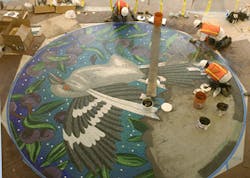D/FW Airport Gets a Medallion Makeover
Carefully, they removed thin, wet protective paper to reveal the artwork beneath: a large mosaic by Fort Worth artist Billy Hassell called Early Morning Flight.
With trowels, they keep the hundreds of tiny tiles level while the grout dries.
"This one will be all finished by tomorrow afternoon," said Tobias Tlusty, a mosaicist with the Franz Mayer artisans.
On Thursday morning, Franz Mayer workers were about halfway done installing seven mosaic floor medallions in Terminal D, part of D/FW's $6 million art program.
Designs created by Metroplex artists were built by Mayer in Germany and are now being installed by hand.
Dallas-based WaterJetWorks will install five cut-stone medallions next week.
Altogether, the 12 medallions are intended to bring a unique visual style to each Terminal D gatehouse. The Terminal D art program, which also includes ballroom-sized paintings and two-story soaring statues, is intended to give passengers a lasting impression of Texas.
"I'm very excited that they're ahead of schedule," said Fort Worth artist Jane Helslander, whose work Floating in Space: A Waltz is one of two medallions already installed. Helslander's creation is a whirlwind of colorful circles.
The other completed work is Cypress Trees, an intricate outdoors design by the late Dallas artist Arthello Beck.
Helslander is a noted painter, and this is her first attempt at public art -- and her first crack at art for the floor.
"It's great that they chose the artists instead of choosing the work," she said. "They picked the artist and then allowed us the freedom to pick the piece."
Helslander had not had a chance to see Mayer's installation of her design, but she said she looked forward to meeting the artisans, as she lived in Munich as a child.
"I'd like to the chance to speak some German," she said.
The medallions are a crucial part of the Terminal D art program, because the works are incorporated into the terminal itself, said Clay Paslay, executive vice president of airport development.
Also, because the mosaic and cut-stone discs are a different texture than the rest of the terrazzo-floored terminal, blind passengers will have a sensory cue that they have reached the gates, Paslay said.
Eventually, passengers who frequent Terminal D may begin to use the designs as a directional guide.
"There is certainly the potential that users will start to remember designs at a particular gate pair," Paslay said.
Meet at Early Morning Flight for an early morning flight? The first chance comes in July, when Terminal D opens to the public.
